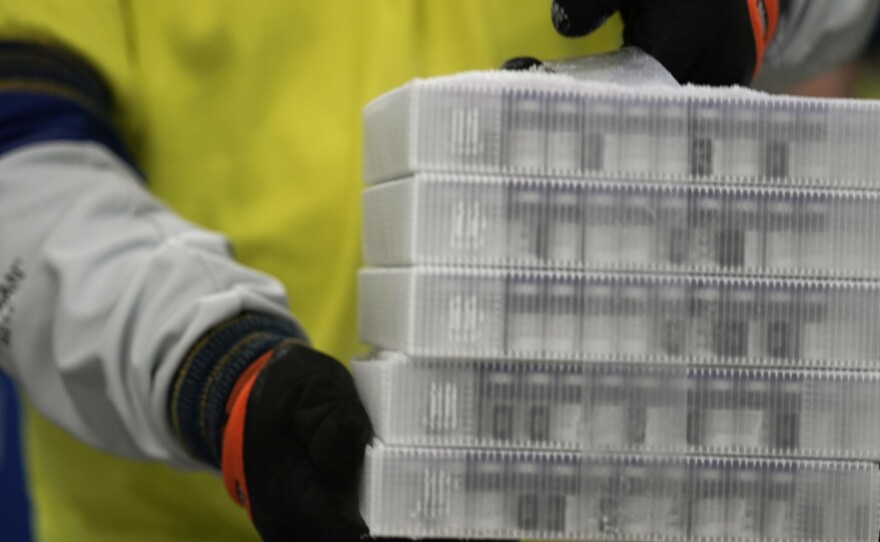President Biden said last Tuesday that his administration is already working on ordering more COVID-19 vaccine doses to increase the U.S. supply through this summer. But before that can happen, Pfizer and Moderna have to fulfill their commitments under their original federal supply contracts.
Each company is responsible for supplying the U.S. government with 100 million doses of the vaccine by March 31. Although both companies will need to significantly increase the number of weekly doses they release to the government to reach those goals, Moderna has made significant progress in the last week.
The federal government has allocated 5.8 million Moderna doses to states this week, according to the latest data from the Centers for Disease Control and Prevention. That's 1.5 million more doses than the 4.3 million the company supplied the previous week — an increase of about 35%.
Meanwhile, Pfizer doses increased only slightly over the previous week — 70,000 doses, or less than 2% — for a total just shy of 4.4 million vaccine doses this week.
"Yesterday, we announced a 16% increase in supply flowing to states every week for the next three weeks to a minimum of 10 million doses per week. That's good news," said Andy Slavitt, White House adviser on the COVID-19 response, at a Wednesday press briefing. The projections can help states with planning.
What he didn't say, but is clear from the allocation data, is that most of the latest supply increase is because of Moderna's additional doses.
"Pfizer and Moderna are committed to delivering a total of 200 million doses by the end of March, with much of it coming at the end of the quarter," Slavit said during the briefing. "So it will accelerate."
That's important because if Moderna continues to release 5.8 million doses a week, it will only have released 85 million doses by the end of March. And if Pfizer continues to release 4.4 million doses a week, it will only have released 72 million doses by the end of March. (This is including the doses already released since both vaccines were authorized by the Food and Drug Administration in December.)
Releasing supply to the federal government doesn't mean the doses physically pass through federal officials' hands. Rather, it means that the companies have told the government these are the first doses they will provide for the following week and the second doses they will provide a few weeks after that. The government can use the information to allocate the doses to states. Once the orders are in, Pfizer ships its vials using FedEx and UPS, while Moderna uses distributor McKesson.
Asked whether the release and allotment numbers from the companies have been accurate, Health and Human Services spokesman Bill Hall said they have been. "To date, the manufacturers and U.S. government have filled all official allocations that have been provided to jurisdictions," he said.
He said government leaders are in "constant communication and dialogue" with the vaccine manufacturers, but conceded it is a "complex and delicate process."
"We have embedded government specialists in key manufacturing facilities and have a team of logistics experts dedicated to aggressively working with industry to proactively identify and solve any bottlenecks in raw materials, supplies, equipment, or skilled labor," he said.
Still, former government officials decried a lack of transparency into the companies' manufacturing supply during a press call organized by Georgetown University on Thursday.
"I don't think there's been a strong tradition of transparency when it comes to vaccine supplies," said Glen Nowak, a former director of media relations at the Centers for Disease Control and Prevention who now leads the Center for Health and Risk Communication in the Grady College of Journalism and Mass Communication at the University of Georgia.
"We saw this when I was at CDC in 2004, when we had a flu vaccine supply shortage. We had a hard time then getting accurate information about how much vaccine was going to be available when," he said. "We sometimes got information, but it often turned out to be not accurate."
Transparency wasn't much better in 2009 regarding the supply of the shingles vaccine, Shingrix, Nowak said. A major government talking point then was to defer to the manufacturer for information.
The COVID-19 pandemic heightens the demand for accurate, timely information. "I still think we need much more transparency from the companies about what they're producing. And I realize it's complicated because ...a lot of this might be proprietary and there's contracts and the like, but these are the company's products," said Bruce Gellin, who used to direct HHS's National Vaccine Program office. "And I think that the company should stand up every week and talk about what their numbers are."
Moderna isn't releasing more detailed supply data, but company spokesman Ray Jordan pointed out that it reaffirmed its supply commitment in a press release on Tuesday.
Pfizer did not respond to NPR's request for comment. But Pfizer CEO Albert Bourla told Bloomberg News on Tuesday that the company could deliver doses to the United States even faster than originally expected and hit 120 million by the end of March, surpassing the commitment of 100 million.
That 20% increase in doses could reflect the unexpected sixth doses found in Pfizer vaccine vials in mid-December. When the Food and Drug Administration authorized the Pfizer vaccine, the vials were thought to contain five doses. Now even the FDA acknowledges that there are six doses inside, though they're only accessible with a special syringe that not every health care provider has access to.
Neither company nor the federal government answered NPR's question about how long it takes to make the vaccine from raw ingredients to ready-to-ship product.
Still, Geoffrey Porges, an analyst at the investment bank SVB Leerink, said he's confident the companies will meet their goals despite the limited doses they've released to the United States each week so far.
He said it's also worth noting that Pfizer has committed to delivering significantly more doses than Moderna outside the U.S. In the United Kingdom, for example, Pfizer will provide 40 million doses through 2021. Moderna has only committed to delivering 7 million doses, starting some time in the spring.
"The confidence that Pfizer is showing about the supply commitments makes me presume that they can step this up through those bottlenecks over the next couple of months," he told NPR.
Pfizer cut back on vaccine deliveries in Europe in mid-January to upgrade production capacity, according to the Associated Press. That especially angered Italy, which is reportedly considering suing the company.
Despite being hard at work on its own vaccine, French drugmaker Sanofi said on Tuesday it will help manufacture the Pfizer vaccine by working with Pfizer's German partner, BioNTech. But those doses will increase supply in Europe, not the United States.
"We will provide BioNTech access to our established infrastructure and expertise to help produce more than 100 million doses of a COVID-19 vaccine in Europe in 2021," a Sanofi spokesperson told NPR in an email. "We will be filling and packaging the vaccine that BioNTech sends us. This should help accelerate the deliveries of vaccine doses to EU countries. We see this as part of our responsibility to helping solve the COVID-19 pandemic. We are moving some work across our different sites to accommodate this, and plan to start in July with the first doses being delivered in August."
You can contact NPR pharmaceuticals correspondent Sydney Lupkin at slupkin@npr.org.
Copyright 2021 NPR. To see more, visit https://www.npr.org.






